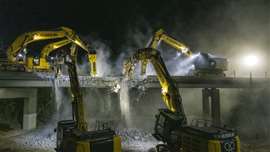WDA Shortlist - Contract of the Year Under US$1 million
28 August 2024
D&Ri is pleased to announce the shortlist for the Contracts Under US$1 million category of the 2024 World Demolition Awards, which will take place on 6 and 7 November October in Stockholm, Sweden, as part of the World Demolition Summit.
Congratulations to the following companies who made it into the shortlist for the Contract of the Year Under US$1 million category.
World Demolition Awards 2024 - Contract Under US$1 million shortlist
 (PHOTO: Demex)
(PHOTO: Demex)
DEMEX
COUNTY: Australia
PROJECT: Wild Duck Island Demolition
CLIENT: QBuild
Demex contracted with QBuild to demolish 20 tourist unit structures and associated facilities on Wild Duck Island off the Central Queensland Coast within a six-week timeframe.
The project presented formidable challenges that could only be overcome by tight, detailed planning for mobilization logistics to set the foundation for undertaking demolition works, waste load out and recycling, while protecting environmental and cultural heritage values.
Logistic planning involved road and sea transport of equipment, materials and personnel from the Gold Coast, transferred to a barge in Gladstone after weed and seed inspection, for shipment to the Island.
Loading and unloading could only be done within tidal timeframes of a few hours when safe for the barge to berth.
A bridge innovation enabled crossing of a protected creek to set up camp for personnel and worksite processing.
Further challenges arose in demolishing extremely dilapidated structures, including friable asbestos, vermin, ants and snakes. Steps were taken to ensure no site contamination occurred.
The project required the careful sorting of demolition materials, which were ground to smallest size to facilitate systematic pay-loading the barge for load-out and demobilization. Again load-out was constrained by tidal variations, needing to be conducted at night with minimal lighting.
Demex was able to report successful completion of the project on time and within budget, and to the satsifcation of the client QBuild, and with the site’s environmental and cultural heritage values restored as befitting the location of Wild Duck Island within the Great Barrier Reef heritage area.
 (PHOTO: P. Olesen)
(PHOTO: P. Olesen)
P. OLESEN
COUNTRY: Denmark
PROJECT: 980 ton Bridge removed over night
CLIENT: MT Højgaard
While this bridge demolition was not a very large project, it has been described as spectacular as it was performed during a single night in October, and the light could be seen form far away.
12 machines worked together to finish the job before daylight and reopen the motorway beneath it in the early morning.
The motorway was closed in the evening and the process of demolition started with covering up the asphalt with iron plates.
P. Olesen then used 12 excavators to cut the bridge from the sides and towards the center of the bridge, in order to reduce weight from the bridge deck.
A total of 980 t off concrete was removed and when almost finished, the foundations of the bridge were also removed.
As the foundations were larger than expected, completing their removal with just a few hours before the motorway reopened was extremely challenging.
The recyclable waste from the bridge was 90% clean concrete, metals and asphalt.
 (PHOTO: Priestly Demolition)
(PHOTO: Priestly Demolition)
PRIESTLY DEMOLITION INC
COUNTY: Canada
PROJECT: Glenbow Museum - Northeast Stairwell
CLIENT: Glenbow Museum, Ellis Don
The Northeast Stairwell Removal at the Glenbow Museum was a unique and challenging complete demolition project that spanned just over 12 months and required patience and perseverance from the team.
There was no simple solution for what was required on this project. The former emergency stairwell was constructed of 1.8 million pounds (816 tonnes) of reinforced concrete that required a tower crane for its removal.
Safety was a major consideration and the number one priority for Priestly Demolition Inc (PDI), which removed the concrete without a single piece being dropped.
The Glenbow Museum has often been described as a “concrete bunker”. No detailed drawings were available, and there was very little information about how the outer concrete panels were attached to the building.
While a tremendous amount of preliminary investigation was needed prior to starting the project, PDI says the team still discovered something new every time a panel came off the side.
A highly detailed engineered plan was designed in-house that also included placement of coring holes, rigging, and customized hydrolift solutions for the panels. No two floors were the same and no two concrete pieces were identical.
In some areas the concrete was 8 inches thick, and in others, 12 inches thick, with various weights. The largest panel to be removed weighed 36,000 lbs (16 t), and measured 20 ft high and 12 ft wide.
For each of the eight floors, PDI separated massive concrete spans into 20 panel sections (160 in total), with each panel weighing between 20,000 to 36,000 lbs (9 t to 16 t).
 (PHOTO: Trifecta)
(PHOTO: Trifecta)
TRIFECTA
COUNTY: United States
PROJECT: Tillman Hall Auditorium Renovation
CLIENT: Clemson University
The restoration of Tillman Hall’s auditorium at Clemson Campus aimed to revive its original historic look while maintaining structural integrity and safety.
Constructed with brick and wood, the building required a full strip-out, with historic items salvaged for reinstallation.
The auditorium featured concrete bleachers, 2-ft-thick, supported by a metal stud framing system over the original wood floor.
Steel structures were added beneath for additional support, and vibration monitoring ensured the historic brick and mortar remained intact.
Key tools included the Brokk 70 Demolition Robot, chosen for its precision. Shore posts with rubber softeners and land bridges made of wood, plywood, and aluminum shoring beams managed weight distribution, protecting the historic floors during material movement.
Preservation efforts focused on original mosaic tiles and historic windows, while full containment with negative pressure addressed asbestos risks during ACM floor tile removal.
Lead-based paint abatement and active fire sprinkler systems ensured safety, as the building remained occupied throughout the renovation. Noise levels were carefully managed to minimise disruption.
Innovations included effective weight distribution methods and advanced demolition tools, ensuring minimal impact on the historic structure.
The project balanced modern demolition techniques with the preservation of historic elements, resulting in a restored auditorium that honors Clemson Campus’s heritage.
CONNECT WITH THE TEAM





